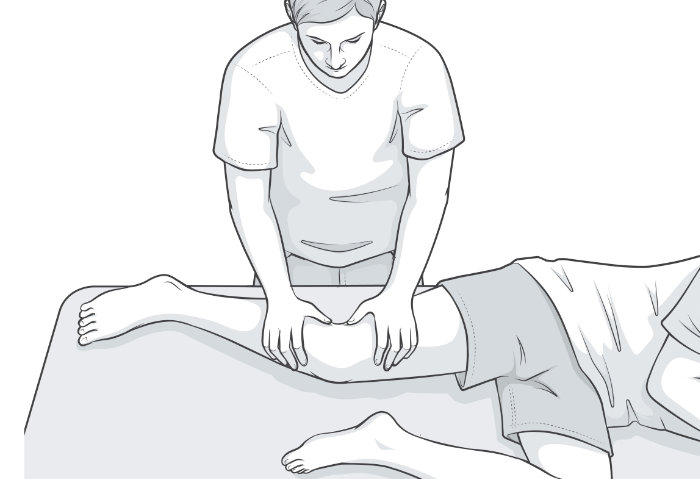The Slocum test is a modification of the anterior drawer test and a positive result indicates damage to the anterior cruciate ligament and/or one of the stabilising structures on the side of the knee.
 Page updated May 2024 by Dr Sheila Strover (Clinical Editor)
Page updated May 2024 by Dr Sheila Strover (Clinical Editor)

The Slocum test assesses anteromedial rotary instability and anterolateral rotary instability of the knee. This means looseness both in a frontwards direction and in twisting movements..
How to perform the Slocum test
-
Quote from peer-reviewed paper:
"When anterointernal tibial luxation is present, a reduction phenomenon is felt as the knee passes into the 25 to 40 degree flexion range. This may occur as a sudden palpable and occasionally audible repositioning which is responsible for such terminology as a "pivot shift" or "jerk sign." "
Citation: Slocum DB, James SL, Larson RL, Singer KM. Clinical test for anterolateral rotary instability of the knee. Clin Orthop Relat Res. 1976 Jul-Aug;(118):63-9. PMID: 954292.
Interpreting a positive Slocum test
An isolated ACL tear will reveal itself on the anterior drawer test, while the Slocum test in addition identifies damage to the medial or lateral structures that also help to stabilise the knee.
These structures may include the superficial and deep medial collateral ligament and the posterior oblique ligament.
What this means in practice is that the surgeon needs to be aware to stabilise these structures during ACL reconstruction, or the reconstruction carries a risk of failure.
-
Quote from peer-reviewed paper:
"....following a combined ACL + MCL injury, [anteromedial rotatory instability] may persist if there is inadequate healing of both the [superficial and deep medial collateral ligament], and MCL deficiency increases the risk of ACL graft failure...." "
Citation: Ball S, Stephen JM, El-Daou H, Williams A, Amis AA. The medial ligaments and the ACL restrain anteromedial laxity of the knee. Knee Surg Sports Traumatol Arthrosc. 2020 Dec;28(12):3700-3708. doi: 10.1007/s00167-020-06084-4. Epub 2020 Jun 5. PMID: 32504158; PMCID: PMC7669770.
- HOMEPAGE
- KNEE DISORDERS
- CRUCIATE LIGAMENT
- CRUCIATE LIGAMENT INJURY
- ANTERIOR CRUCIATE LIGAMENT INJURY
Other relevant material -
- Anterior drawer test
- Pivot shift test
- Lachman test
- Anteromedial rotatory instability
- Anterolateral rotatory instability
Course - 2009 -
 2009 - Posterolateral corner injuries of the knee - by Dr Frank R Noyes (Knee Surgeon)
2009 - Posterolateral corner injuries of the knee - by Dr Frank R Noyes (Knee Surgeon)